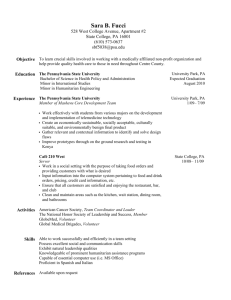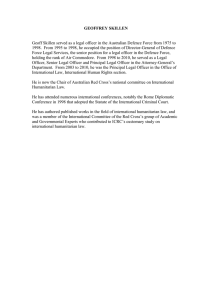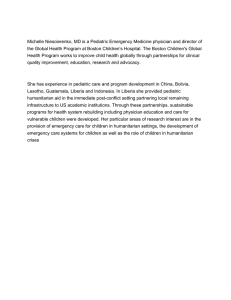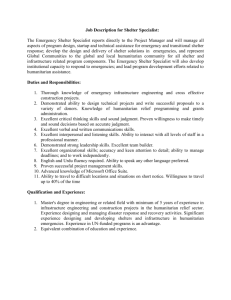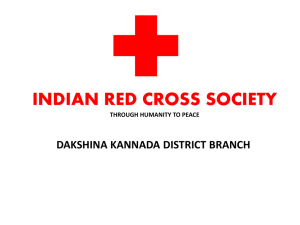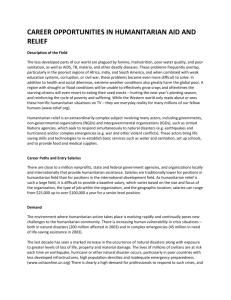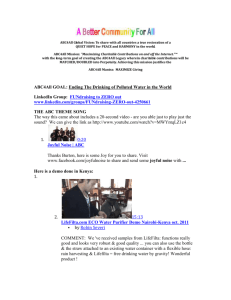STRATEGIC-LEVEL ROLES AND COORDINATION
advertisement
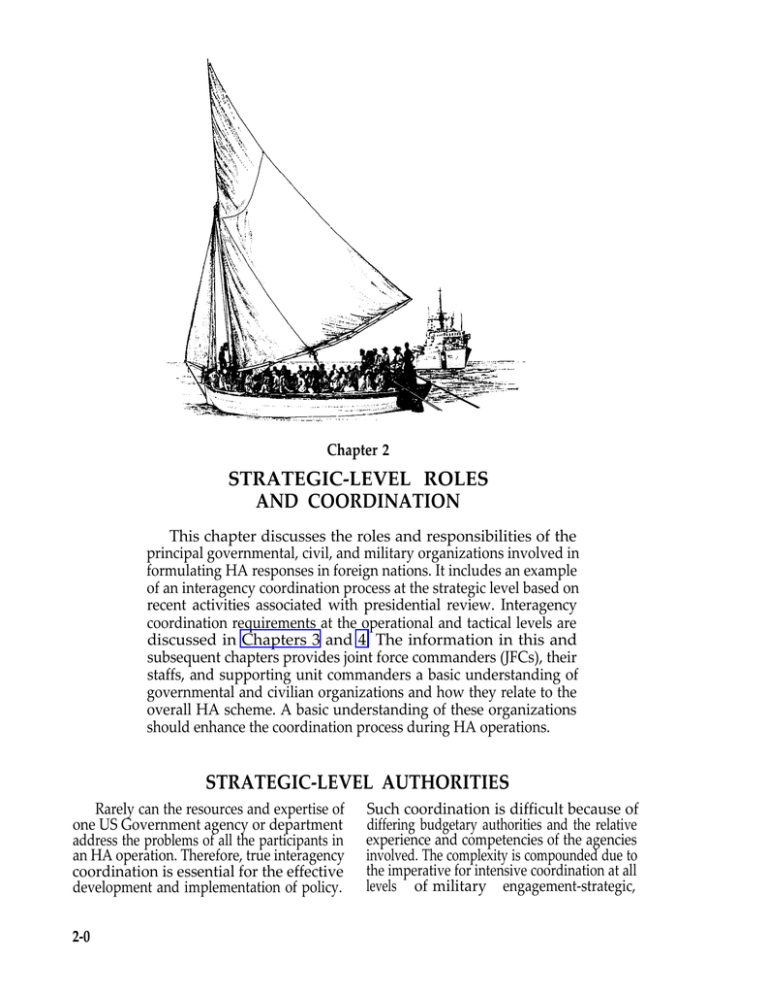
Chapter 2 STRATEGIC-LEVEL ROLES AND COORDINATION This chapter discusses the roles and responsibilities of the principal governmental, civil, and military organizations involved in formulating HA responses in foreign nations. It includes an example of an interagency coordination process at the strategic level based on recent activities associated with presidential review. Interagency coordination requirements at the operational and tactical levels are discussed in Chapters 3 and 4. The information in this and subsequent chapters provides joint force commanders (JFCs), their staffs, and supporting unit commanders a basic understanding of governmental and civilian organizations and how they relate to the overall HA scheme. A basic understanding of these organizations should enhance the coordination process during HA operations. STRATEGIC-LEVEL AUTHORITIES Rarely can the resources and expertise of one US Government agency or department address the problems of all the participants in an HA operation. Therefore, true interagency coordination is essential for the effective development and implementation of policy. 2-0 Such coordination is difficult because of differing budgetary authorities and the relative experience and competencies of the agencies involved. The complexity is compounded due to the imperative for intensive coordination at all levels of military engagement-strategic, Chapter 2 operational, and tactical. While the armed forces have developed doctrinal techniques and procedures to facilitate coordination within their structures, they often do not match or harmonize with the techniques and procedures used by other governmental, nongovernmental, and international organizations. At the strategic level, the US authority begins with the NCA and continues through senior DOS and DOD representatives, with cooperation from other cabinet authorities and the total involvement of the supported and supporting combatant commanders. In UN operations, strategic-level planning is not as clearly defined. One of the challenges for US military planners at strategic levels is to determine when and with what other organizations to begin the coordination process. decision. Its membership includes four statutory Vice-President, members—the President, Secretary of State, and Secretary of Defense. The CJCS and the Director of the Central Intelligence Agency serve as statutory advisors to the NSC. The President may appoint other advisors. By directive of 15 September 1993, the NSC designated the USAID Administrator as the Special Coordinator for International Disaster Assistance. The special coordinator (SC) performs his interagency coordination functions for the US in complex international emergencies through the interagency working group (IWG) which he chairs or cochairs with a representative of the NSC. NATIONAL AUTHORITIES Authorities on the US national level include the NCA the US Congress, DOS, DOD, other cabinet-level departments, and USAID. The NCA is supported in its decision-making process by the National Security Council (NSC) and in interagency coordination by the Administrator for USAID, who is the President’s Special Coordinator for International Disaster Assistance. Department of State DOS or the US ambassador in country is responsible for declaring a foreign disaster or situation that requires HA. Usually, the ambassador declares a disaster based upon a request for assistance from the host country government and input from the US country team. The US ambassador in a given country has authority to declare a disaster in order to provide immediate relief assistance and start the process that may lead to increased US assistance. To determine the policy for a particular relief operation, DOS may also lead an IWG in those cases not convened by the SC or NSC. DOS is organized in functional and regional bureaus. The key participating bureau is the regional bureau of the affected country and may include the bureaus of Refugee Programs, International Organizational Affairs, PoliticalMilitary Affairs, and Human Rights and Humanitarian Affairs (see Figure 2-1). National Command Authorities The President and SECDEF form the NCA. The term NCA is used to signify constitutional authority to direct the armed forces to execute military action. Only the NCA can authorize movement of troops and execution of military action. By law, no one else in the chain of command has the authority to take such action. The NCA may direct relief operations when a serious international situation threatens the political or military stability of a region of interest to the US, or when the NCA deems the humanitarian situation by itself sufficient and appropriate for employment of the armed forces. The NCA issues its orders through the Chairman of the Joint Chiefs of Staff (CJCS) to the combatant commanders. National Security Council The NSC is the principal forum to consider national security issues requiring presidential CABINET-LEVEL AUTHORITIES Cabinet-level authorities consist of DOS, DOD, USAID, and other cabinet-level authorities. Department of Defense The Under Secretary of Defense for Policy is the principal officer for policy coordination within DOD. He is responsible for developing the military policy for international HA and foreign relief operations. The Deputy Assistant Secretary for Humanitarian and Refugee Affairs proposes 2-1 Humanitarian Assistance the policy and oversees the administration of existing statutory programs (see Figure 2-2). DOD officials participate in IWGs that the SC or NSC normally chair or cochair. DOD is represented in other IWGs on humanitarian emergencies that either it, DOS, or USAID may chair (see Figure 2-3). Joint Staff The primary joint staff-level proponent for HA policy is the Director for Strategic Plans and Policy, J5. In addition, the Director for Logistics, J4, through the logistics readiness center (LRC), oversees the execution of logistics support for HA operations that the services normally carry out. The Director for Operations, J3, gets involved when a military force is to be inserted into the AO as a part of the US response to the 2-2 crisis. Figure 2-4 depicts the organization of the joint staff and illustrates those directorates that interface to support HA. Enthusiastic cooperation by supporting unified commands was also critical to success. The Transportation Command’s resident liaison officer effected much of the coordination for the strategic movement of coalition forces into the theater. Security assistance officers from US European Command and US Pacific Command, as well as defense attaches worldwide, received and responded to a USCENTCOM-developed questionnaire requesting critical posture and support requirements data. Operation Restore Hope—A USCENTCOM Perspective Chapter 2 2-3 Humanitarian Assistance The joint staff is responsible for designating the supported and supporting commands for any operation, including HA missions. Once the relationships of supported and supporting CINCs have been established, detailed coordination at the staff level will progress. 2-4 Agency for International Development USAID plays an important role in providing HA Although not directly under the control of DOS, USAID coordinates activities at cabinet and country team levels. Its efforts are executed in three phases—relief, rehabilitation, and reconstruction. Chapter 2 The USAID organization for HA is shown in Figure 2-5. Relief is usually coordinated under the auspices of the Bureau for Humanitarian Response. The bureau coordinates its efforts through OFDA. This office, discussed in detail in Chapter 3, participates in planning at the operational level. Other Cabinet-Level Authorities NSC and DOS have the authority to augment the IWG by requesting required expertise from cabinet-level offices. Cabinet-level representation depends on the nature of the operation under consideration. The Departments of Agriculture, Treasury, and Transportation (DOT); the Office of Management and Budget; and the US Information Agency may play a role in the development of the strategic plan. For example, the Coast Guard, as an agent for DOT, has capabilities that can significantly enhance joint HA efforts. These include maritime search and rescue, port safety and security, marine environmental response, maritime refugee processing, maritime interception force operations, and law enforcement on navigable waters. COORDINATING AUTHORITY Interagency coordination parameters begin at the strategic level. For greatest effectiveness, coordination must begin at the first signs of a developing complex emergency. Above all, successful coordination involves comprehensively engaging all the organizational and functional tools at the appropriate points and places on the disaster time line in order to deal with the crisis. Response Triad Each HA situation is unique and requires a unique response. Three essential elements— political, military, and humanitarian—are present whenever HA is provided. The critical coordination of these elements can be portraved as a response triad, as illustrated in Figure 2-6. 2-5 Humanitarian Assistance USCENTCOM had to overcome the challenges of coordinating with a variety of civilian agencies. The Department of State formed the Government Interagency Task Force, Somalia to coordinate the US Government response to the crisis. Nearcontinuous communication between the joint staff and USCENTCOM sewed as the primary means of ensuring the unified received position commander’s interagency policy consideration in discussions. Operation Restore Hope-A USCENTCOM Perspective Commanders of a large-scale HA must carefully balance these essential elements to ensure success. Each element complements the other two and each must be represented at every level of HA, from policy making to distribution of relief supplies in the field. US governmental, civil, and military authorities; other governments; the UN; and NGO, PVO, and IO relief agencies share 2-6 responsibilities for the conduct of humanitarian relief operations. With so many organizations involved, planners at the strategic and operational levels may encounter problems because the strategic plans and goals of these organizations may not be compatible with military objectives. An effective response can be described as a triad at both national and international organizational levels. The components of such a triad are humanitarian, political, and security organizations. Effective US action in such an environment necessitates strong central coordination and leadership and should include interface with NGOs, PVOs, and IOs. The diverse participants compound the complexity of an operation. Appendix C discusses organizations that may be found in an AO conducting HA operations. Special Coordinator for International Disaster Assistance directive of Through the NSC 15 September 1993, the USAID Administrator plays the major interagency coordinating function for the US Government in his designated capacity as the President’s Special Coordinator for International Disaster Assistance. The principal Chapter 2 staff backup for discharging this central coordinating function is OFDA. When the NCA determines that a US response to a complex emergency may be required, the SC may be directed to convene an appropriate IWG to recommend the policy and actions that should be followed. The IWG merges information received from all appropriate cabinet-level representatives, to include the US ambassador to the UN, regional organizations, and the US ambassador or chief of the mission. The ambassador or chief of mission will usually gather input by consulting with the country team. The IWG immediately develops an information collection plan and tasks all sources to implement the plan. The unified commander is an important source who will modify his own collection plan to support the requirement created by the complex emergency. This information is usually communicated through the country team but also follows channels through the CJCS to the DOD representative on the IWG. Another potential source is the political advisor assigned to the CINC who can link directly with the DOS representative on the IWG. Figure 2-3 depicts the interagency coordination process at the strategic level. Interagency Planning Concurrently, the IWG develops a comprehensive strategy and plan of operations with tasks for each of the key participants. Key to the development of a sound strategic plan is the inclusion of all elements that should be involved in the crisis. The SC must ensure the integrity of this comprehensive process. In addition, to ensure a coordinated approach, the unified commander needs to consider how to integrate ongoing incountry programs under Title 10 authorities. Key to the development of sound recommendations is including other elements that may be involved in the crisis. For example, DOS should consider the involvement of USAID, UN organizations, and NGOs, PVOs, and IOs that may be operating in the country. Various organizations may establish a crisis task force or crisis action team to manage the situation. The difficulties in integrating strategic, operational, and tactical-level planning with the diverse mixture of other organizations involved can be minimized through an active interface role of the SC. The SC needs to facilitate the links between the military and those organizations whose structures and procedures are not as formally defined as those of the military. The SC is responsible for coordinating these planning and operational interfaces throughout the life cycle of a complex humanitarian emergency. INTERNATIONAL AUTHORITIES Integration of strategic, operational, and tactical-level planning with other organizations involved in the HA operation is difficult. The main reason for this difficulty is that other organizational structures are not as defined as those in the military. As a result, no comparable match exists to that of the US military system. This does not mean these organizations do not have a chain of command. Planning follows the concepts contained in each of their charters and often takes place on all levels. Further, some UN agency charters can be interpreted to have overlapping mandates. The organizations also tend to tailor their support to the crisis and, as a result, their network is more ad hoc than that found in a traditional military organization. For this reason, experience shows that relationships with organizations mature as an operation develops, and these relationships and linkages require constant nurturing. The roles and responsibilities of the organizations discussed below should provide military planners with the requisite knowledge to develop the interagency linkages needed to assure the success of an operation. UNITED NATIONS The UN is involved in the entire spectrum of operations, ranging from prevention to relief, 2-7 Humanitarian Assistance through reconstruction and rehabilitation, to development. Usually, UN relief agencies establish independent networks to execute their humanitarian relief operations. Although the UN system seems to delegate as much as possible to the agency elements located in the field, a supervisory and support network can be traced from the UN headquarters to field officers. A relief operation may occur due to manmade or natural causes. Although the UN may be involved in HA operations without a resolution from the Security Council or the General Assembly, the type of operations envisioned will probably be launched under the auspices of an approved UN resolution. The UN organization for complex emergencies normally includes headquarters and field components. The UN Under Secretary General for the UN Department of Humanitarian Affairs (UNDHA), as the UN emergency coordinator, normally serves as the headquarters component. Field-level organization currently relies on the resident coordinator system administered by the UN Development Program (UNDP). The resident coordinator mobilizes and manages the UN country team and provides direction for the field relief effort. In most serious emergencies, the UN Secretary General may appoint a special representative who reports directly to the Secretary General on all matters but also to the UN emergency coordinator (UNDHA) on humanitarian matters. Many UN staff elements may get involved in the provision of humanitarian relief. Planners must understand the differences between the two major arms of the UN that participate in HA. The UN organization in New York deals with issues of policy and international security. Additionally, this arm maintains the command and control center that coordinates UN peace operations around the globe. The UN organization in Geneva, on the other hand, deals specifically with HA. Although the involvement of UN staff elements is governed by the specifics of the situation, UNDHA is generally held responsible for coordinating HA at the equivalent US military strategic level. Strategic and operational planners should 2-8 consult representatives of this UN department when developing recommendations for the involvement of US military forces. This consultation may take place through USAID/ OFDA rather than through direct UN-DOD/ unified command interface. United Nations Objectives Military commanders of HA forces must have a working knowledge of the aims and objectives pursued by the UN organizations in the AO. This knowledge is essential during the planning process to reconcile the objectives of the military plan with UN HA objectives. These broad objectives areTo keep the emergency from happening, or when an emergency threatens, to mitigate its effects. To minimize human casualties and destruction of property by ensuring the survival of the maximum number of victims through effective relief actions. To reestablish self-sufficiency and essential services as soon as possible for all affected populations, with special attention to the most vulnerable segments such as children, the disabled, and the elderly. To ensure that relief action promotes and does not impede rehabilitation and longerterm development efforts. Activities should contribute to long-term development goals. To protect the main effort and humanitarian relief implementers through judicious use of the security component of the triad. To find durable solutions as quickly as possible, with special attention to displaced and affected populations, while assuring protection and assistance in the process. United Nations Peacekeeping Traditional UN peacekeeping operations (PKO) take place around the globe, where over 70 nations have contributed more than 75,000 troops. US military forces may conduct HA simultaneously or in coordination with a UN PKO. Therefore, commanders and staffs should understand success factors for UN PKOs and apply them to HA, particularly in the mission- Chapter 2 planning stages. Analysis indicates that for UN PKO to be successful— Peacekeeping forces must have the support of all belligerent parties. Presence of the peacekeeping force must be tied to ongoing efforts for a negotiated settlement of the dispute. Hostile parties must be separated and substantially disarmed. In addition, operations that do not meet these PKO success factors will have an even higher probability of failure when the following conditions exist: The mandate is ambiguous or unclear. The terrain is poor. A clear cease-fire line does not exist. Troops are deployed to cities. Weapons are readily available. The UN PKO chain of command is poorly disciplined. United Nations Response The UN system is often called upon to assist the affected governments with large-scale relief operations. The level of assistance and its effectiveness depend largely on the coordination efforts at both the international and country levels. The nature of the emergency also plays a large role in determining the specific support required. UN prevention and response can also be categorized as a triad of humanitarian, political, and security components analogous to the US triad mentioned earlier. See Appendix D for more detailed descriptions of UN agencies that support HA. OTHER INTERNATIONAL ORGANIZATIONS Outside of the UN, the primary international organizations participating in HA involve groupings of the Red Cross/Red Crescent Movement. It is critical to point out that these groups are distinctly different and have separate mandates and staff organizations. They should not be considered as one organization. International Red Cross and Red Crescent Movement Three Red Cross organizations make up the International Red Cross and Red Crescent Movement: the International Committee of the Red Cross, the International Federation of Red Cross/Red Crescent Societies, and the individual national Red Cross and Red Crescent organizations. The objective of the movement is to coordinate their entire range of activities. For example the statutes of the movement give the ICRC some flexibility in situations not covered by the Geneva Conventions. Figure 2-7 depicts the relationships within the movement. Neutrality is a vital aspect in the involvement of any Red Cross or Red Crescent organization in HA. Their objective is to protect their neutrality in reality and in perception. The protection of this neutrality is a key consideration for joint military planners and operators. International Committee of the Red Cross. The ICRC is international only in the sense of its worldwide operations; it is essentially all Swiss. The ICRC works for the application of the provisions of international humanitarian law in armed conflicts and undertakes tasks incumbent upon it under this law. Founded in 1863, this international organization is based in Geneva and derives its mandate from the Geneva Conventions of 1949 and the two additional protocols of 1977. The ICRC is distinct from the rest of the movement in that it has a protection mandate in addition to its relief assistance work. It acts principally in cases of conflict, ensuring legal protection for victims and acting as a neutral, independent humanitarian player in the most complex emergency situations. At times the ICRC may get involved in strictly humanitarian operations, but its mandate is to function during armed conflict. International Federation of Red Cross and Red Crescent Societies. This organization was formed in 1919 and consists of the National Red Cross or Red Crescent Societies that normally operate within the borders of their own countries. The mandate of the federation is to provide humanitarian relief during 2-9 Humanitarian Assistance disasters. Red Cross and Red Crescent organizations may provide assistance to other federation members through their international alliance provisions. National Red Cross and Red Crescent Societies. The National Red Cross and Red Crescent Societies are created by countries to provide for humanitarian relief within their own borders. International Organization for Migration The International Organization for Migration (IOM) performs three primary missions: 2-10 The processing and movement of refugees to countries offering them resettlement opportunities. The provision of orderly and planned migration to meet emigration and immigration requirements of losing and gaining countries. The transfer of technology through the movement of qualified human resources to promote economic, educational, and social advancement of developing countries. The IOM has demonstrated a strong competence in capacity-building for indigenous governments and NGOs. Namely, it conducts interactive training workshops to increase Chapter 2 knowledge of disaster management and build teamwork for interagency preparation and response for complex emergencies. the US country team, particularly OFDA disaster assistance response team (DART) representatives. NONGOVERNMENTAL AND PRIVATE VOLUNTARY ORGANIZATIONS The JTF may find many NGOs and PVOs in the AO. Over 350 agencies, many of which are capable of responding in HA operations, are registered with USAID. Some foreign-based organizations are not required to register inl the US. USAID publishes a yearly report that describes the aims and objectives of the registered organizations. This report should be part of the combatant commander’s library. Appendix C contains a description of NGOs and PVOs that have disaster-relief field experience. Disaster assistance evolution will likely expand the number of NGOs and PVOs in the future. NGOs and PVOs, as they are known in North America, are organizations, both national and international, that are constituted separately from the government of the country in which they are founded. They range from multimillion dollar organizations with decades of worldwide experience in disaster relief to newly created small organizations, dedicated to the particular disaster in question. Military commanders and other decision makers should understand the following key elements about the NGO and PVO community: Military interactions with the NGO and PVO community should be coordinated with missions, and The characteristics, capabilities of individual NGOs and PVOs are diverse. All are involved in direct humanitarian aid with host populations. Each organization operates individually. 1. Voluntary Foreign Aid Programs, 1994. NGOs and PVOs provide the bulk of HA at the grassroots level. The military structure can provide logistics and security assistance to remote and unsecured areas. NGOs and PVOs may operate in areas of high risk, where other organizations are hesitant to go. NGO and PVO assessments are often an excellent source of information on the HA situation. NGOs and PVOs are funded primarily by donations from the public as well as governments and the UN. They may have scarce resources, both at the donor level and in the field. NGOs and PVOs will probably operate in the affected area long after the military leaves. Therefore, military commanders should consider the implications of any US military HA projects they initiate in the field. 2-11


